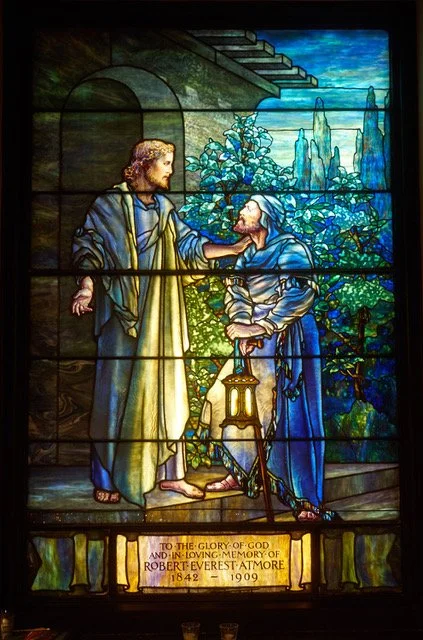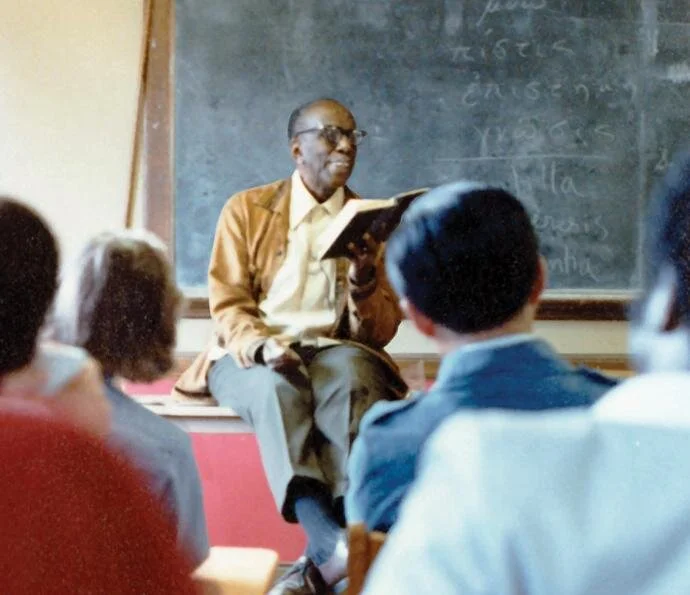Friday Reflection: Philadelphia’s First Mystics–The Hermits of the Wissahickon
Reflecting upon mysticism, monasticism and the active contemplatives of colonial Peru led me—startlingly—home to earliest Philadelphia. There, I found an astonishing community of male mystics, a colorful part of Germantown history, that was as quietly seminal as it was famously mysterious and short-lived (1694-early 18th century).
I blush to admit this community was new to me, though I’ve lived in Philadelphia for decades. As has happened repeatedly in lockdown, questions to Google (mystics, monastics, Philadelphia) took me to myriad websites on the subject, that then led me—delightedly— down a ravine trail in a city park 20 minutes away.
Some of what little we know about the community derives from the chronicles of its successor, the Ephrata Cloister established in 1732 in Lancaster County, PA, by Johann Conrad Beissel after finding the Wissahickon group largely disbanded in 1720, when he arrived hoping to join them.
Still, local lore abounded. The group still appeals to the popular local imagination as “our” wizards, with occult powers from the ancients that brought spine tingling prestige to the region. One manuscript claims, for example, their leader was the last to possess the Philosopher’s Stone; as he died, he ordered it tossed, for safety, into the nearby Schuylkill River with spectacular explosive results. Imagine what Steven Spielberg could do with that, per “Indiana Jones and the Raiders of the Lost Ark”. . . .
Today, the colony’s retreat to wilderness makes us dream or cringe: huts or caves in the steep, now densely-wooded ravine cut by Wissahickon Creek as it flows to the Schuylkill.
They were the radical fringe of William Penn’s signature target for settlement, those seeking haven from religious persecution in Europe, particularly Pietists like himself, the Friends (also called Quakers). This group, however, came from Germanic countries.
Later generations regularly dismissed these hermits as yet more doomed crazies, their early dissolution considered proof of the unsustainability of their beliefs: asceticism, celibacy, and particularly millennialism (engaged with the Apocalypse, the imminent end of this epoch described in the Book of Revelation; often called Christ’s Second Coming). The last was especially urgent and defining since the group’s destination was the expected site of the Second Coming within months. Which didn’t happen then or at any new date established.
There are ever more studies of the Brotherhood and individual members, as well as specialist works on their thought, writings, and music that build on the pioneering research of amateur historian and photographer Julius Friedrich Sachse (1842-1919). His 1896 book German Pietists of Provincial Pennsylvania nonetheless remains the standard text on the subject. A Kelpius Society, named for the group’s leader (about whom more below), now promotes serious research on the subject.
There are many reasons to study this group, an informal monastic community as they were considered then. But here, I’m going to sketch their known history to then focus on their engagement with their neighbors as active contemplatives, particularly their forms of public worship with them.
A Unique Monastic Community Is Born
To appreciate their mission and motivation, we must understand the world that shaped them.
The prospect of religious freedom and tolerance that defines Pennsylvania is no casual matter, given how pervasive intolerance and persecution were in seventeenth-century Europe. After the Counter-Reformation and its aftermath (a religious war that only escalated state hostility to religious differences), those who deviated from state religious orthodoxies suffered, from loss of jobs to execution.
Among such rogues in Germany were Lutherans called Pietists for their view of true piety as the lived faith, the experience of a direct relationship with God, aided by study of Scripture, rather than by learning a theology that seemed abstract, disconnected from life and God. Viewing every worshipper as a priest, these Pietists rejected official clergy and church hierarchy, subverting the authority of—and very need for—any Church. They also believed in the imminence of the Second Coming. The Roman Catholic Church pursued Pietists for heresy through the Inquisition. The Lutheran Church, the state Church of some Germanic countries, was equally harsh.
Illustration from an English edition of Jakob Böhme’s work
The key mover in our story, given these dangers, is one such beleaguered Pietist, a brilliant Lutheran minister, scholar, widely respected astronomer, and musician named Johann Jakob Zimmerman (1642-1693) who was dismissed from his ministry and exiled repeatedly from German cities for his views. Zimmerman’s vision was especially complex. Following Jakob Böhme, an eminent advocate of the occult and the direct relationship with God, Zimmerman adapted older non-Christian philosophies to ally language, mathematics, astrology, and other sciences into a vision of divine presence and messages that appeared in the natural world (from sound to the skies), words, numbers—and miracles. Zimmerman was also associated with alchemy, and was said to hold the Philosopher’s Stone as a means to reduce human suffering.
While in Hamburg he gathered followers to form a community on land obtained through William Penn’s European agents. Zimmerman chose around 40 companions—guided by the most powerful number in his system—all unmarried, highly educated males of like mind whom he called the Chapter of Perfection for their qualities and mission. Zimmerman himself, however, was married with children who would travel with them.Their destination: virgin acreage outside an infant city Penn named Philadelphia, near a new settlement for Mennonites and Quakers from Germany that became Germantown.
All signs were providential, according to Zimmerman’s astrological calculations and the biblical Book of Revelation.They were to settle in wilderness: crucial site for purification away from the carnal world; site of the Second Coming, near a new city named for its biblical counterpart (today, Alaşehir, Turkey) blessed by God for its vitality and loyalty to his Word, along the 40th parallel north (again, the power number). In Philadelphia, the 40th parallel north is most easily marked at the intersection of Clearfield St. and N. Broad St., southeast of Wissahickon Valley Park. The community of 40 would live and work in that wilderness, preparing themselves spiritually for the Second Coming expected in the summer of 1694—and for subsequent life within that millennium before the end of Time and the Last Judgment.
Christopher Witt, Portrait of Johannes Kelpius, 1705
Before dying unexpectedly on the eve of their departure from Rotterdam in late 1693, Zimmerman proposed a new Magister [Leader] from within the group, Johannes Kelpius (1667/1673-c. 1708). Kelpius is the Latinized version of his baptismal name, Kelp, upon obtaining his advanced university degree, per local academic practice. Kelpius also, like other members of the group, continued to wear his German academic gown in the new colony, providing an exotic monk-like appearance to its members among other Pietists.
Kelpius was a slight, frail, brilliant youth in his 20s from Transylvania (present-day Romania), son of a Lutheran pastor with deep study in theology, command of various languages and disciplines (including music, vocal and instrumental), proven leadership skills, and strong adherence to Zimmerman’s vision. Zimmerman also gave Kelpius his scientific instruments to track cosmic signs and, reportedly, the Philosopher’s Stone to reduce suffering. Rosicrucians honor Kelpius as one of their own, though many question the association.
The group arrived in Philadelphia on June 23, 1694, providentially St. John’s Eve. The settlement’s exact acreage and location are still not clear. Before they left, a supporter offered thousands of acres in the area for minimal rent. Sachse (p. 205), however, claimed the Philadelphia surveyor general Thomas Fairman gave them 175 acres. Their title is still missing, apparently, even though the property changed hands repeatedly afterward. Now part of Fairmount Park, the Hermitage mansion, named partly in their honor, was built in 1848 on the reported site of their community center called the Tabernacle, about which more below. A much-modified “cave” within the ravine near the Hermitage, called the “Hermit’s Cave” since at least Sachse’s time (see the image above), is widely thought to be Kelpius.’ Here’s my general view of the site taken on my initial visit to the area this month.
The presumed “Hermit’s Cave” September 2020
Despite the debates about its identity, its current simplicity and setting help us to imagine the colony’s wild, ascetic, secluded quarters, however changed over time.
The Active Contemplatives: Seclusion and Service
The group apparently took no name, even Zimmerman’s Chapter of Perfection, though they reportedly acknowledged one: The Contented of the God-loving Soul. Instead, their activity and setting spoke for them. They shaped a world within the wooded ravine that combined seclusion and social service, loosely along a monastic model; more about that later.
Their lived faith made little distinction between the active (service) and contemplative (prayer). In some monastic orders, service was considered more helpful towards salvation than contemplation. Below, we'll see two members of the group acting on that premise.
Their individual cells or huts served as residences and sites for private meditation, study, and prayer. They were relatively self-reliant, cultivating their own garden and orchard for food. Though they avoided religious leaders, they structured their colony with officers bearing different responsibilities, headed by the Magister.
They built a square log Tabernacle (40’ x 40’ per their mystic numerology, sited along the cardinal points), topped by an observatory, on the ridge’s summit. There, they scanned the skies for divine signs at night and pursued communal or public activities during the day. Their free social services were much in demand, especially their school, though Germantown’s mayor (and paid developer) ran one as well. They were deeply and daily engaged with the town, often thanks to individual skills. One member was a bookbinder and town title clerk for his exquisite calligraphy; another the court crier, among other civic duties. Citizens admired their ceaseless works of mercy on their behalf. An English physician and polymath named Dr. Christopher Witt (or De Witt), who arrived around 1703, developed an active medical practice among Germantonians that grew when he bought a house there as the hermits scattered.
The Woman in the Wilderness
Like many Pietist sects, this community preached.Their sermons, religious services, Bible study, and education aimed to prepare as many as possible for the Second Coming and beyond, a process of perfection. Kelpius wrote and printed devotional “moral cards” and pamphlets to disseminate among Germans. He reportedly hoped to establish a Universal Church for all German sects. According to Sachse (p. 75), the group held services and religious education in Germantown as well as in their Tabernacle. They preached to the local Lenni Lenape for the same purpose. Their sermons invoked Revelation so frequently, as the harrowing picture of the Second Coming centered on the beleaguered Woman in the Wilderness (Rev. 12:6), that many identified the group by that name.
I haven’t yet found any written “Rule” that governed their community, like traditional monastic examples, much less a daily schedule. More on worship below. Individuals were reportedly free to retreat to their cells for prayer or study if not engaged in communal or public activities. For the night watch for cosmic signs of the Second Coming, it’s possible they established a rotation for the assignment unless only specialists qualified. There appear to have been few limits other than to avoid Sin: gaming, dancing, theater, carnal challenges to celibacy as they awaited reunion at the Second Coming with the divine Sophia, their other half lost at the Fall and replaced by Eve.
The expected millennial signs, however, failed to appear. Zimmerman’s announced date of 1694 passed without any. One manuscript reports a possible sighting 7 years later: A celestial apparition one night that suggested an angel formed, then disappeared as their prayers intensified, then reappeared two nights later, but never again. And no Second Coming then or at any point later.
Some commentators concluded this no-show of the announced Second Coming was the reason for the colony’s failure, dealing a fatal blow to belief. Still other observers commented that Kelpius’ death around 1708, apparently of tuberculosis, shattered their bond weakened without the expected Second Coming, though the colony continued under new leadership with decreasing numbers. Sachse noted two members moved into the growing urban centers because they considered service more important and more productive in preparing for the elusive Second Coming than prayer.
All views may have some truth. However, those who left to marry or live in Germantown retained their close bond with the Brotherhood. Former members and “outside” neighbors took in the hermits when seriously ill, including Kelpius himself. Rather than viewing their departure as defection or failure, we might instead consider that the group’s mission spread, evolved in the hands of others, as other Pietist doctrines did.
Kelpius himself, however, held fast to the original vision, as we learn from a letter of 1706 to English Quaker Esther (or Hester) Palmer Champion, perhaps the most succinct statement of the group’s creed.Through this letter to an influential Quaker, Kelpius’ thought spread into local Quaker instructional writings (Patrick M. Erben, A Harmony of the Spirits. . . .[UNC Press Books, 2012], 219)
How the Group Worshipped
What little is currently available emphasizes, as mentioned above, that this colony practiced private worship and public services in town and the Tabernacle. We still know little about any worship schedule or even liturgy.
Their public services included voiced elements—hymn singing and group prayer—to fuse, through human sound, their diverse fold into one in search of union with God, their goal in all. As surviving prayer pamphlets and hymnals suggest, they encouraged ethnic and linguistic diversity: Even early versions, in manuscript only, appear in both English and German.
These services also included an alternative form of prayer found in Pietist sects, monastic orders, and the Desert Fathers: silent, wordless inward prayer as Paul proposed (Romans 8:26).
For Kelpius, this was the most perfect prayer. As he wrote in Short, Easy, and Comprehensive Method of Prayer (various posthumous English editions are available online), inward prayer is “the only means to attain perfection in this life and to kindle the pure and disinterested love in our hearts.”
It is everyone’s means, “even the most simple and ignorant, who are also capable of performing this order or manner of prayer.”
Its connection with God is swift: It “brings us soonest to the union with and conformity to the Will of God. . . .“
Its wordlessness is essential: “For one may pray without forming or uttering any words, without consideration or speculation of the mind, without holding rational discourses, or making conclusions, yea, without knowing the least thing in the manner relative to the outward senses. And this prayer is the Prayer of the Heart, the unutterable prayer, the most perfect of which is the fruit of Love. . . .“
Given especially its monastic roots, the “unutterable prayer” is authentically Christian despite its seeming challenge to the authority of the Word. Its forms are protean, especially with the enriching adaptations from Asian counterparts.
The group’s customized monasticism, and particularly this ancient form of prayer, I think, have much to teach us in this extraordinary Now.
Covid19 and its devastating impact this last year invite a church to explore infinite ways to engage with the once-unthinkable experience. The silent, “unutterable prayer” seems wonderfully right as an essential, primal address, in this distraught, disorienting time, to within, alone or communally.
As St. Stephen’s considers what forms of worship might suit its post-Covid19 future, as an historic urban church that has pursued unprecedented approaches in the past, it has many options. Wordless silent prayer offers much going forward—in person and online. The many websites for online silent prayer groups and vigils suggest its potential beyond lockdown, since online life promises to be with us going forward.
The mix of online and in-person responds to need as it evolves.
For worship in-person, the spaces of St. Stephen’s have already proved to be friends to silence. I found a brief meditation or inward prayer in an Advent service last year to be powerful. Embraced by the church’s warm and intimate space, the group experienced a strong bond that facilitated their individual quests, the silence as eloquent, in its own way, as the spoken words. Set perhaps in the Furness Burial Cloister, the experience might come even closer to the monastic model.
Silence, itself a Place and Presence, encourages free-flowing connection, listening. Thank you, Johannes Kelpius, for your words about—wordlessness.
—Suzanne Glover Lindsay, St. Stephen’s historian and curator









